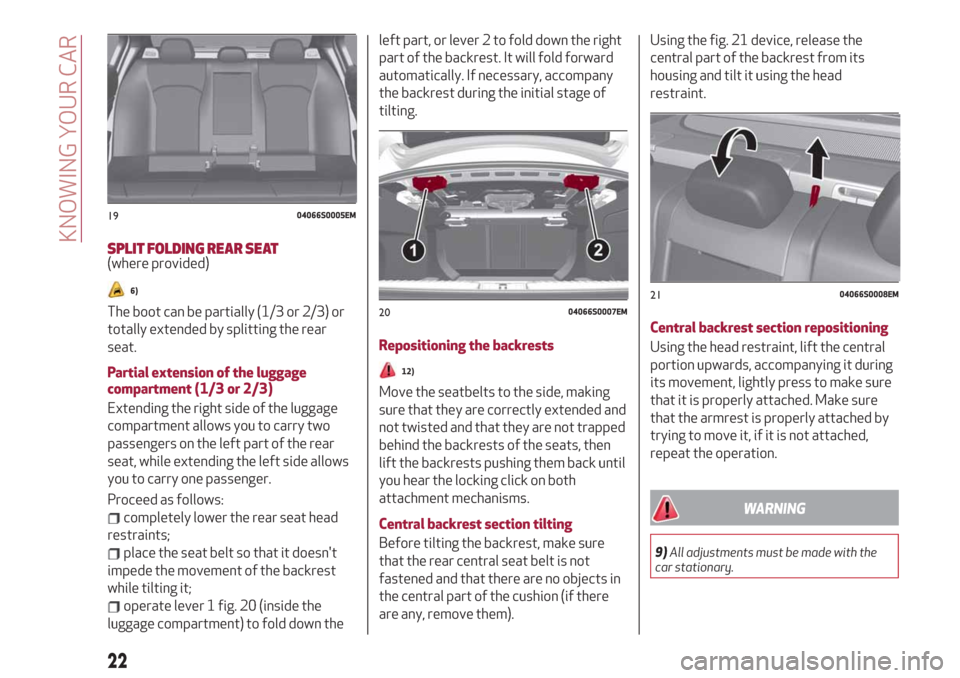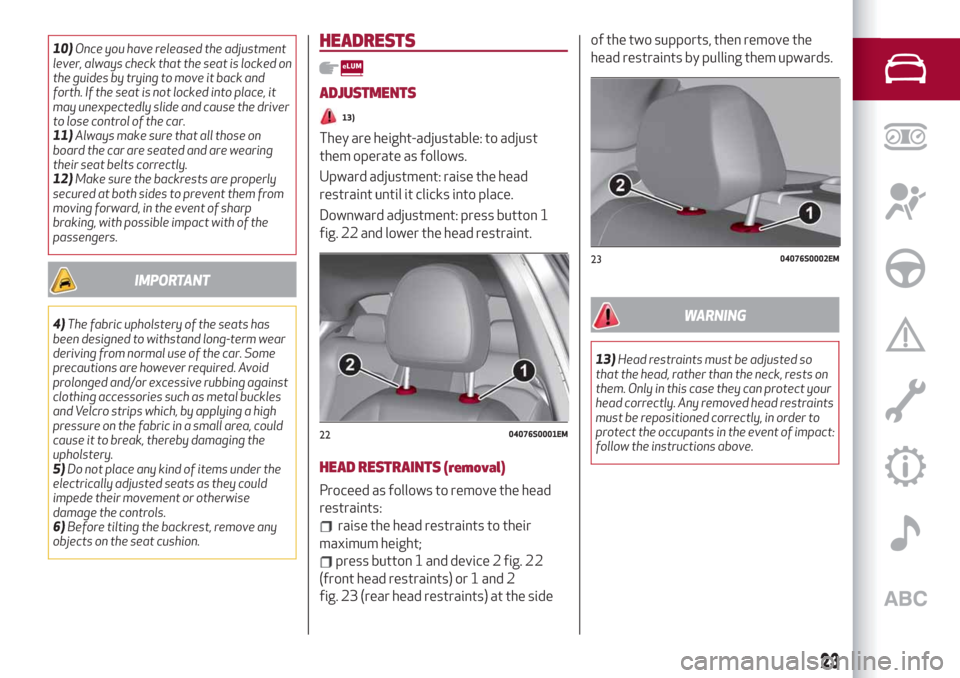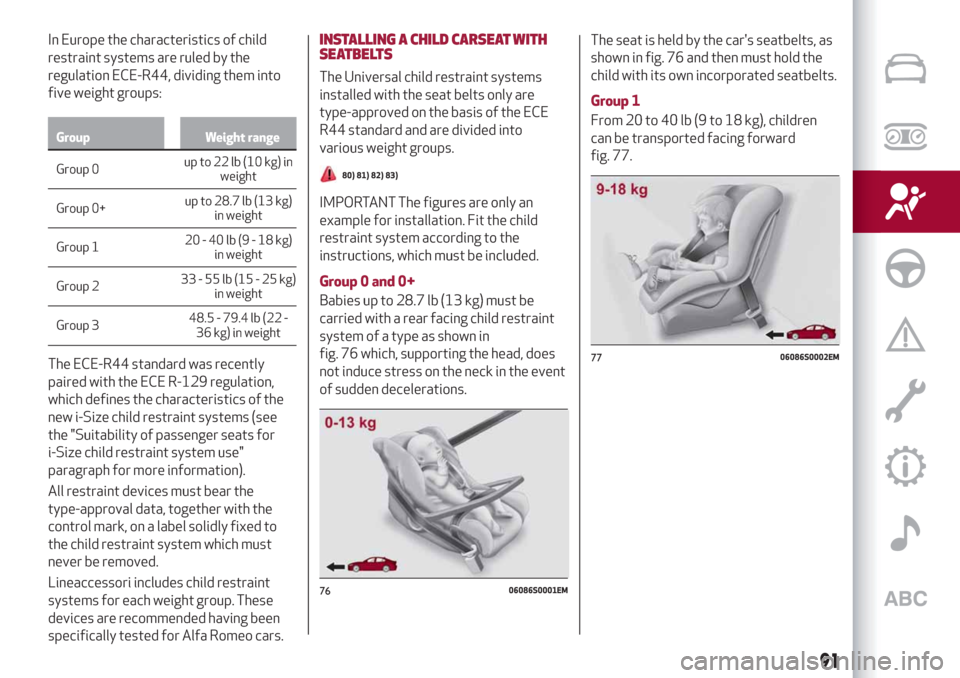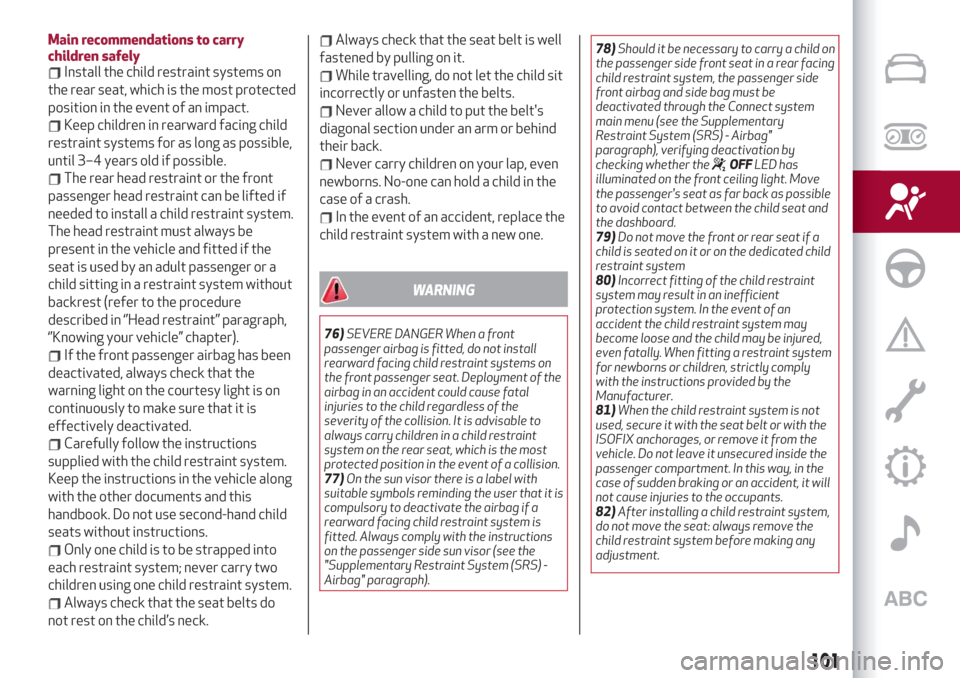remove seats Alfa Romeo Giulia 2019 Owner's Manual
[x] Cancel search | Manufacturer: ALFA ROMEO, Model Year: 2019, Model line: Giulia, Model: Alfa Romeo Giulia 2019Pages: 232, PDF Size: 4.87 MB
Page 24 of 232

SPLIT FOLDING REAR SEAT(where provided)
6)
The boot can be partially (1/3 or 2/3) or
totally extended by splitting the rear
seat.
Partial extension of the luggage
compartment (1/3 or 2/3)
Extending the right side of the luggage
compartment allows you to carry two
passengers on the left part of the rear
seat, while extending the left side allows
you to carry one passenger.
Proceed as follows:
completely lower the rear seat head
restraints;
place the seat belt so that it doesn't
impede the movement of the backrest
while tilting it;
operate lever 1 fig. 20 (inside the
luggage compartment) to fold down theleft part, or lever 2 to fold down the right
part of the backrest. It will fold forward
automatically. If necessary, accompany
the backrest during the initial stage of
tilting.
Repositioning the backrests
12)
Move the seatbelts to the side, making
sure that they are correctly extended and
not twisted and that they are not trapped
behind the backrests of the seats, then
lift the backrests pushing them back until
you hear the locking click on both
attachment mechanisms.
Central backrest section tilting
Before tilting the backrest, make sure
that the rear central seat belt is not
fastened and that there are no objects in
the central part of the cushion (if there
are any, remove them).Using the fig. 21 device, release the
central part of the backrest from its
housing and tilt it using the head
restraint.
Central backrest section repositioning
Using the head restraint, lift the central
portion upwards, accompanying it during
its movement, lightly press to make sure
that it is properly attached. Make sure
that the armrest is properly attached by
trying to move it, if it is not attached,
repeat the operation.
WARNING
9)All adjustments must be made with the
car stationary.
1904066S0005EM
2004066S0007EM2104066S0008EM
22
KNOWING YOUR CAR
Page 25 of 232

10)Once you have released the adjustment
lever, always check that the seat is locked on
the guides by trying to move it back and
forth. If the seat is not locked into place, it
may unexpectedly slide and cause the driver
to lose control of the car.
11)Always make sure that all those on
board the car are seated and are wearing
their seat belts correctly.
12)Make sure the backrests are properly
secured at both sides to prevent them from
moving forward, in the event of sharp
braking, with possible impact with of the
passengers.
IMPORTANT
4)The fabric upholstery of the seats has
been designed to withstand long-term wear
deriving from normal use of the car. Some
precautions are however required. Avoid
prolonged and/or excessive rubbing against
clothing accessories such as metal buckles
and Velcro strips which, by applying a high
pressure on the fabric in a small area, could
cause it to break, thereby damaging the
upholstery.
5)Do not place any kind of items under the
electrically adjusted seats as they could
impede their movement or otherwise
damage the controls.
6)Before tilting the backrest, remove any
objects on the seat cushion.
HEADRESTS
ADJUSTMENTS
13)
They are height-adjustable: to adjust
them operate as follows.
Upward adjustment: raise the head
restraint until it clicks into place.
Downward adjustment: press button 1
fig. 22 and lower the head restraint.
HEAD RESTRAINTS (removal)
Proceed as follows to remove the head
restraints:
raise the head restraints to their
maximum height;
press button 1 and device 2 fig. 22
(front head restraints) or 1 and 2
fig. 23 (rear head restraints) at the sideof the two supports, then remove the
head restraints by pulling them upwards.
WARNING
13)Head restraints must be adjusted so
that the head, rather than the neck, rests on
them. Only in this case they can protect your
head correctly. Any removed head restraints
must be repositioned correctly, in order to
protect the occupants in the event of impact:
follow the instructions above.
2204076S0001EM
2304076S0002EM
23
Page 93 of 232

In Europe the characteristics of child
restraint systems are ruled by the
regulation ECE-R44, dividing them into
five weight groups:
Group Weight range
Group 0up to 22 lb (10 kg) in
weight
Group 0+up to 28.7 lb (13 kg)
in weight
Group 120-40lb(9-18kg)
in weight
Group 233-55lb(15-25kg)
in weight
Group 348.5 - 79.4 lb (22 -
36 kg) in weight
The ECE-R44 standard was recently
paired with the ECE R-129 regulation,
which defines the characteristics of the
new i-Size child restraint systems (see
the "Suitability of passenger seats for
i-Size child restraint system use"
paragraph for more information).
All restraint devices must bear the
type-approval data, together with the
control mark, on a label solidly fixed to
the child restraint system which must
never be removed.
Lineaccessori includes child restraint
systems for each weight group. These
devices are recommended having been
specifically tested for Alfa Romeo cars.
INSTALLING A CHILD CARSEAT WITH
SEATBELTS
The Universal child restraint systems
installed with the seat belts only are
type-approved on the basis of the ECE
R44 standard and are divided into
various weight groups.
80) 81) 82) 83)
IMPORTANT The figures are only an
example for installation. Fit the child
restraint system according to the
instructions, which must be included.
Group 0 and 0+
Babies up to 28.7 lb (13 kg) must be
carried with a rear facing child restraint
system of a type as shown in
fig. 76 which, supporting the head, does
not induce stress on the neck in the event
of sudden decelerations.The seat is held by the car's seatbelts, as
shown in fig. 76 and then must hold the
child with its own incorporated seatbelts.
Group 1
From 20 to 40 lb (9 to 18 kg), children
can be transported facing forward
fig. 77.
7606086S0001EM
7706086S0002EM
91
Page 103 of 232

Main recommendations to carry
children safely
Install the child restraint systems on
the rear seat, which is the most protected
position in the event of an impact.
Keep children in rearward facing child
restraint systems for as long as possible,
until 3–4 years old if possible.
The rear head restraint or the front
passenger head restraint can be lifted if
needed to install a child restraint system.
The head restraint must always be
present in the vehicle and fitted if the
seat is used by an adult passenger or a
child sitting in a restraint system without
backrest (refer to the procedure
described in ‘’Head restraint’’ paragraph,
‘’Knowing your vehicle’’ chapter).
If the front passenger airbag has been
deactivated, always check that the
warning light on the courtesy light is on
continuously to make sure that it is
effectively deactivated.
Carefully follow the instructions
supplied with the child restraint system.
Keep the instructions in the vehicle along
with the other documents and this
handbook. Do not use second-hand child
seats without instructions.
Only one child is to be strapped into
each restraint system; never carry two
children using one child restraint system.
Always check that the seat belts do
not rest on the child’s neck.
Always check that the seat belt is well
fastened by pulling on it.
While travelling, do not let the child sit
incorrectly or unfasten the belts.
Never allow a child to put the belt's
diagonal section under an arm or behind
their back.
Never carry children on your lap, even
newborns. No-one can hold a child in the
case of a crash.
In the event of an accident, replace the
child restraint system with a new one.
WARNING
76)SEVERE DANGER When a front
passenger airbag is fitted, do not install
rearward facing child restraint systems on
the front passenger seat. Deployment of the
airbag in an accident could cause fatal
injuries to the child regardless of the
severity of the collision. It is advisable to
always carry children in a child restraint
system on the rear seat, which is the most
protected position in the event of a collision.
77)On the sun visor there is a label with
suitable symbols reminding the user that it is
compulsory to deactivate the airbag if a
rearward facing child restraint system is
fitted. Always comply with the instructions
on the passenger side sun visor (see the
"Supplementary Restraint System (SRS) -
Airbag" paragraph).78)Should it be necessary to carry a child on
the passenger side front seat in a rear facing
child restraint system, the passenger side
front airbag and side bag must be
deactivated through the Connect system
main menu (see the Supplementary
Restraint System (SRS) - Airbag"
paragraph), verifying deactivation by
checking whether the
OFFLED has
illuminated on the front ceiling light. Move
the passenger's seat as far back as possible
to avoid contact between the child seat and
the dashboard.
79)Do not move the front or rear seat if a
child is seated on it or on the dedicated child
restraint system
80)Incorrect fitting of the child restraint
system may result in an inefficient
protection system. In the event of an
accident the child restraint system may
become loose and the child may be injured,
even fatally. When fitting a restraint system
for newborns or children, strictly comply
with the instructions provided by the
Manufacturer.
81)When the child restraint system is not
used, secure it with the seat belt or with the
ISOFIX anchorages, or remove it from the
vehicle. Do not leave it unsecured inside the
passenger compartment. In this way, in the
case of sudden braking or an accident, it will
not cause injuries to the occupants.
82)After installing a child restraint system,
do not move the seat: always remove the
child restraint system before making any
adjustment.
101